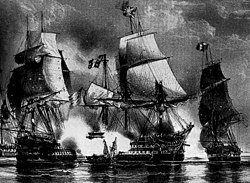Horatio Nelson
Vice-Admiral Horatio Nelson (29 September 1758 – 21 October 1805)[1][2] was an British sea captain in the Royal Navy.
Born at the rectory of the village of Burnham Thorpe, Norfolk,[3][4] Nelson commanded the British fleet during the Napoleonic Wars, fighting the French and the Spanish. Nelson was blind in one eye after he had been wounded in battle.[5]
During the Battle of Trafalgar, his greatest victory, he was killed by a French sniper.
Last words
At least three versions of his last words exist and are shown in Wikiquote.
His most well-known last words are "Kiss me, Hardy".
Another statement during his last hours was "Thank God I have done my duty."[1]
An alternative version is that he said both of those statements. He said "Kiss me, Hardy," When Hardy kissed him on the cheek. Then, Nelson said, "Now I am satisfied. Thank God I have done my duty."[4] Next, Hardy kissed him again on the forehead, when Nelson called out, "Who is that?" Hardy replied, "It is Hardy."[4] Nelson said, "God bless you, Hardy."[4] Finally, he murmoured to those around him to look after Emma Hamilton and his daughter.[4]
Most recently, accounts of his chaplain, Alexander Scott; his steward, Chevalier; and the purser, Walter Burke state that Nelson said, "Drink, drink. Fan, fan. Rub, rub." That was a request to ease the symptoms of thirst, heat, and the pains of his wounds.[6]
Scott, who remained by Nelson as he died, recorded Nelson's last words as "God and my country."[7]
Horatio Nelson Media
The site of the rectory in Burnham Thorpe in Norfolk, where Nelson was born in 1758
Captain Horatio Nelson, painted by John Francis Rigaud in 1781, with Fort San Juan—the scene of his most notable achievement up to that point—in the background. The painting itself was begun and nearly finished prior to the battle, when Nelson held the rank of lieutenant; when Nelson returned, Rigaud added the new captain's gold-braided sleeves.
Nelson's Column – Death of Nelson at Trafalgar panel, with George Ryan standing on the left-hand edge, holding a rifle
Nelson's wife, Lady Nelson, formerly Frances "Fanny" Nisbet of the island of Nevis, West Indies. A painting of the British school, circa 1800, formerly attributed to Richard Cosway, from an earlier copy.
Nelson receives the surrender of the San Nicholas, an 1806 portrait by Richard Westall
Nelson wounded during the Battle of Santa Cruz de Tenerife; 1806 painting by Richard Westall
Battle of the Nile, 1 August 1798 at 10 pm, painting by Thomas Luny, 1834
Lady Hamilton as either a bacchante or Ariadne, by Élisabeth Louise Vigée Le Brun, c. 1790; a painting owned by Nelson, which hung above his bed until his death
Castello di Maniace, caput of the Dukedom of Bronte, situated 5 miles north of the town of Bronte. Viewed from north across the dried up river bed of the River Saraceno, with Mount Etna in the background (the main crater of which is 15 km to the south-east). Painted in 1876 by Sir John Walrond, 1st Baronet (1818–1889), son-in-law of the 3rd Duchess of Bronte. Royal Collection
References
- ↑ 1.0 1.1 Mullet, Charles F. (1978). "Nelson, Horatio". World Book Encyclopedia. Vol. 14. World Book-Childcraft International Inc. p. 113-115. ISBN 0716600781.
- ↑ "BBC: History: Historic Figures: Admiral Horatio Lord Nelson (1758 - 1805)". BBC. Retrieved 2011-03-29.
- ↑ Horsley, E. M. (1986). Hutchinson Factfinder: Concise Encyclopedia. London: Guild Publishing.
- ↑ 4.0 4.1 4.2 4.3 4.4 Iggulden, Hal; Iggulden, Conn (2006). The Dangerous Book for Boys. HarperCollins. p. 154-158. ISBN 9780007232741.
- ↑ N.A.M. Rodger, ‘Nelson, Horatio, Viscount Nelson (1758–1805)’, Oxford Dictionary of National Biography, Oxford University Press 2004; online edn, May 2009 accessed 5 Oct 2009
- ↑ Pocock, Tom (1987). Horatio Nelson. London: The Bodley Head. p. 331. ISBN 0-370-31124-8.
- ↑ Hayward, Joel S. A. (2003). For God and Glory: Lord Nelson and His Way of War. ISBN 1-59114-351-9.p. 63










